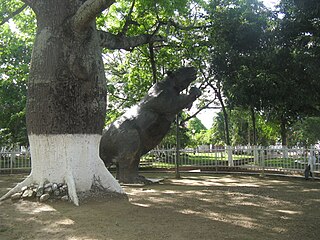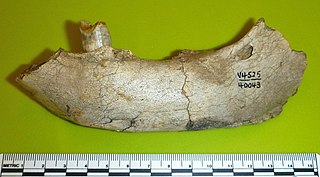
Peltephilus, the horned armadillo, is an extinct genus of armadillo xenarthran mammals that first inhabited Argentina during the Oligocene epoch, and became extinct in the Miocene epoch. Notably, the scutes on its head were so developed that they formed horns. Aside from the horned gophers of North America, it is the only known fossorial horned mammal. P. ferox had skull about 11.7 centimetres (4.6 in), and estimated body mass is around 11.07 kilograms (24.4 lb).

Hapalops is an extinct genus of ground sloth from the Early to Late Miocene of Brazil, Bolivia, Colombia, and Argentina in South America.

Theosodon is an extinct genus of litoptern mammal from the Early to Middle Miocene of South America.
La Venta is a fossil locality located in the modern departments of Tolima and Huila in Colombia. This site is one of the richest Neogene fossil assemblages in South America and represents the best-known Cenozoic fossil site outside of Argentina. It provides a glimpse of what life in the region was like before the main wave of the Great American Interchange.
Stirtonia is an extinct genus of New World monkeys from the Middle Miocene. Its remains have been found at the Konzentrat-Lagerstätte of La Venta in the Honda Group of Colombia. Two species have been described, S. victoriae and the type species S. tatacoensis. Synonyms are Homunculus tatacoensis, described by Ruben Arthur Stirton in 1951 and Kondous laventicus by Setoguchi in 1985. The genus is classified in Alouattini as an ancestor to the modern howler monkeys.
The Laventan age is a period of geologic time within the Middle Miocene epoch of the Neogene, used more specifically within the SALMA classification in South America. It follows the Colloncuran and precedes the Mayoan age.

Xenastrapotherium is an extinct genus of astrapothere, a type of hoofed herbivorous mammal, native to South America, which lived in the Middle to Late Miocene period, typically during the Laventan stage. It is a member of the family Astrapotheriidae in the subfamily Uruguaytheriinae, large astrapotheres, equipped with a trunk-like nose and protruding teeth, similar to the elephants, but their tusks were the canine teeth, not the incisors. Xenastrapotherium was a genus widely distributed in northern South America, in contrast to other species of astrapotheres which lived in the area of the Southern Cone of the continent. It differed from other astrapotheres by having two lower incisors on each side of the jaw and the tusks have a pronounced longitudinal curvature, although their general shape and size are probably very similar to Astrapotherium, whose weight would be 900 to 1,500 kilograms, comparable to the current black rhinoceros.

Hoffstetterius is an extinct genus of toxodontid notoungulate mammal, belonging to the subfamily Toxodontinae whose remains were discovered in the Middle to Late Miocene Mauri Formation in the La Paz Department in Bolivia. The only described species is the type Hoffstetterius imperator.

The Honda Group is a geological group of the Upper and Middle Magdalena Basins and the adjacent Central and Eastern Ranges of the Colombian Andes. The group, in older literature also defined as formation, is in its present-day type section in the Tatacoa Desert in the department of Huila subdivided into two main formations; La Victoria and Villavieja.
Saimiri fieldsi is an extinct species of New World monkey in the genus Saimiri from the Middle Miocene. Its remains have been found at the Konzentrat-Lagerstätte of La Venta in the Honda Group of Colombia.

Boreostemma is an extinct genus of glyptodonts from northern South America. Fossils assigned to the genus were first described as belonging to Asterostemma from southern South America, but have been placed in the new genus Boreostemma by Carlini et al. in 2008. The type species is B. pliocena. Fossils of Boreostemma have been found in the Honda Group of Colombia, in Peru and Venezuela.
Paratrigodon is an extinct genus notoungulate belonging to the subfamily Toxodontinae, containing one species, P. euguii. Like its close relative Trigodon, it is known for the presence of a horn-like protuberance on its forehead. Fossils of Paratrigodon are known from the Arroyo Chasicó Formation dating from the Chasicoan period, and teeth from the Laventan-aged Quebrada Honda Fauna of Bolivia were also associated with the genus, although considered too different from the type species to be assigned to it.
Proterotherium is an extinct genus of litoptern mammal of the family Proterotheriidae that lived during the Late Miocene of Argentina and Chile. Fossils of this genus have been found in the Ituzaingó Formation of Argentina, and the Galera Formation of Chile.
Promacrauchenia is an extinct genus of macraucheniids that lived during the Late Miocene to Late Pliocene epochs of what is now Argentina and Bolivia. It belongs to the subfamily Macraucheniinae, which also includes Huayqueriana, Macrauchenia, and Xenorhinotherium. Fossils of this genus have been found in the Ituzaingó, Andalhuala, and Cerro Azul Formations of Argentina.
Megadolodus is an extinct genus of proterotheriid litopterns.
Prolicaphrium is an extinct genus of proterotheriid litoptern that lived during the Early Miocene, in what is now Argentina. Fossils have been found in the Sarmiento Formation of Argentina.
Pericotoxodon is an extinct genus of toxodontid notoungulate, from the Miocene period. Fossils of Pericotoxodon were found near Río Inuya and Mapuya in Peru, and in La Venta, Colombia and Bolivia, in deposits dated to the Middle Miocene.

Notopithecus is an extinct genus of Notoungulate, belonging to the suborder Typotheria. It lived from the Middle to the Late Eocene and its fossilized remains were discovered in South America.

Magdalenabradys is an extinct genus of mylodontid ground sloths that lived during the Middle Miocene and Early Pliocene of what is now Colombia and Venezuela. Fossils have been found in the Villavieja Formation of the Honda Group in Colombia, and the Codore and Urumaco Formations of Venezuela.






















